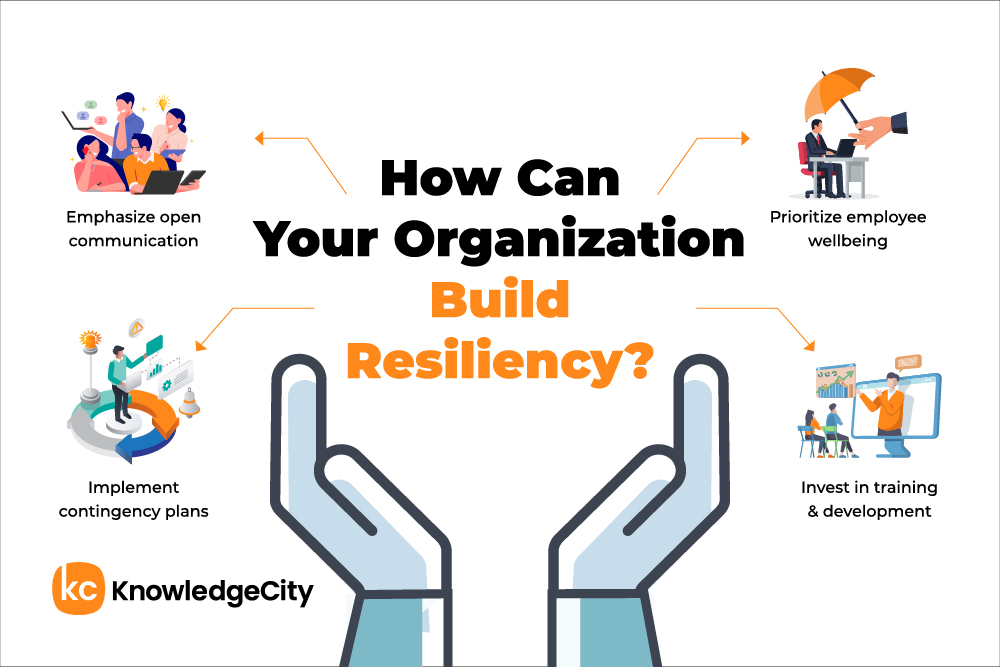What Makes an Organization Resilient?
In the ever-evolving landscape of the business world, one quality stands out: resilience. This is the ability to anticipate challenges, promptly adapt, and strategically use adversity as a catalyst for growth.
When we think about resilience, we often think of bouncing back from adversity. However, in an organizational context, resilience isn’t just about recovery. It’s also about foresight and flexibility.
Resilient organizations can see potential roadblocks and adapt to shifting dynamics. This resilience is interwoven into an organization’s routines, strategies, and culture. This fosters quick recovery, continuous learning, and agile adaptation. Resilience forms a tapestry that allows an organization to dance with disruption rather than dodge it.

Why Is Resilience Important?
Organizations must navigate increasingly disruptive and uncertain landscapes that test their endurance, agility, and creativity. They grapple with economic uncertainties, global pandemics, digital disruption, and shifts in consumer preferences.
Resilient organizations don’t just withstand these issues; they embrace them as catalysts for transformation and growth.
As the Harvard Business Review highlights, resilient organizations demonstrate superior performance, increased competitiveness, and enhanced stakeholder confidence. They showcase a proactive approach that translates potential threats into stepping stones for progress, continually reinforcing their standing in the marketplace and driving sustainable growth.
Resilience Builds a Strong Team
An organization’s strength is connected to its teams’ resilience. Building resilience in teams goes beyond fostering an environment that encourages endurance in the face of setbacks.
It’s about cultivating a team culture anchored in trust, open communication, and shared purpose. This fuels a collective capability to absorb shocks and thrive amid uncertainty.
As the Forbes Business Council emphasizes, resilient teams are characterized by high levels of collaboration, adaptability, and innovation. They have a shared understanding of their roles, goals, and strategies to achieve them. These teams excel in problem-solving and decision-making, allowing them to swiftly adapt to changing circumstances.
Strategies for Building Organizational Resilience
Building resilience in business is a strategic and intentional process. It isn’t an overnight change but a gradual, consistent effort that demands commitment from all levels of the organization.
Here are several key strategies that HR professionals and leaders can employ to foster organizational resilience:
Promote a culture of resilience: This begins at the top. Leaders play a critical role in setting the tone for resilience, and they do so by modeling resilient behavior. Leaders who demonstrate flexibility, empathy, and tenacity set a precedent for others to emulate. Encouraging a growth mindset is crucial; it fosters an environment where mistakes are seen as learning opportunities and challenges are viewed as catalysts for innovation.
Emphasize open and transparent communication: In uncertain times, clear and consistent communication can significantly reduce anxiety and confusion. Regularly updating employees about organizational changes, imminent challenges, and strategic plans enhance mutual understanding and trust within the team. This will bolster their collective resilience.
Prioritize employee wellbeing: A resilient organization values and cares for its people. Prioritizing well-being involves implementing wellness programs, providing flexible work options, and extending support for employees’ mental health. Per the Center for Creative Leadership, a healthy and supported workforce is more engaged, more productive, and consequently, more resilient.
Invest in training and development: Provide your team with the necessary skills and knowledge to navigate and adapt to new challenges. This includes training in problem-solving, stress management, and change management. By equipping your employees with these skills, you foster a culture of resilience that permeates every level of the organization.
Implement robust contingency plans: Resilience is as much about preparation as it is about adaptation. Establish comprehensive contingency plans that address a range of potential crises. Regularly reviewing and updating these plans ensure they stay relevant and effective, providing a solid safety net that strengthens organizational resilience.
In a world marked by unpredictability and disruption, organizational resilience is non-negotiable. By infusing resilience into organizational routines and cultivating strength in teams, organizations can stay dynamic and competitive amid the ever-changing business world.
Subscribe to Our Newsletter
Join 80,000+ Fellow HR Professionals. Get expert recruiting and training tips straight
to your inbox, and become a better HR manager.

 Chuk Otakpor
Chuk Otakpor 










